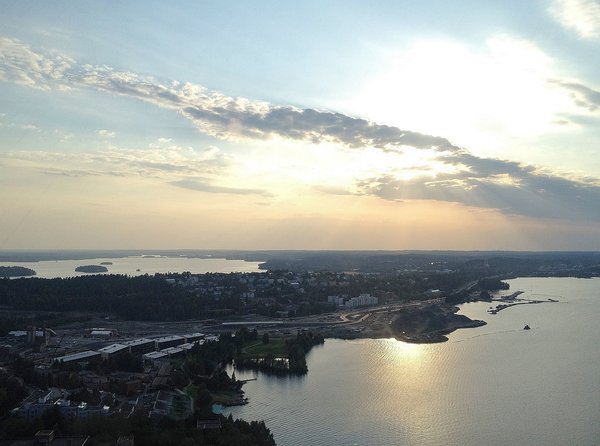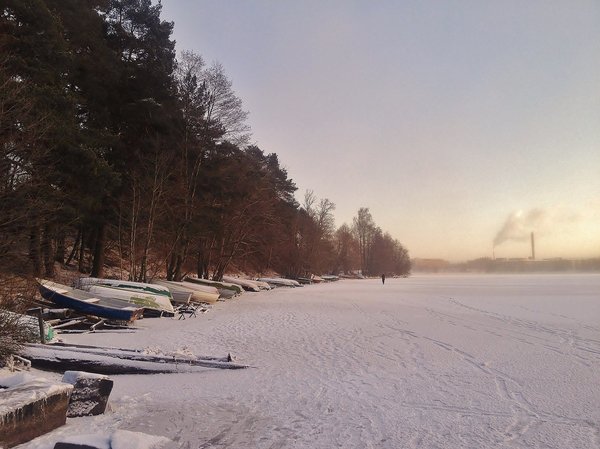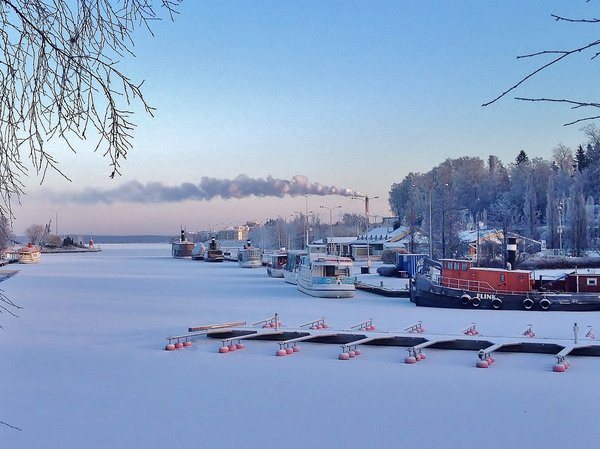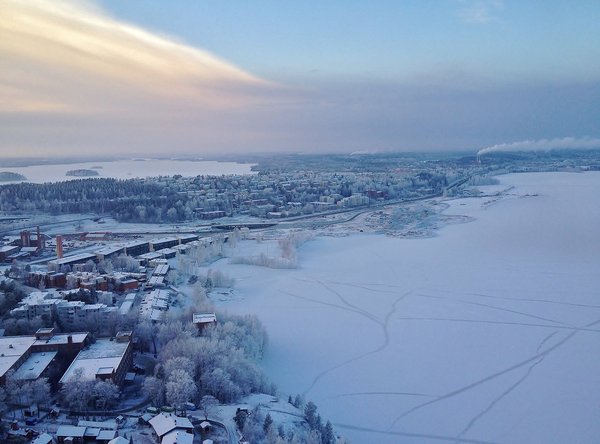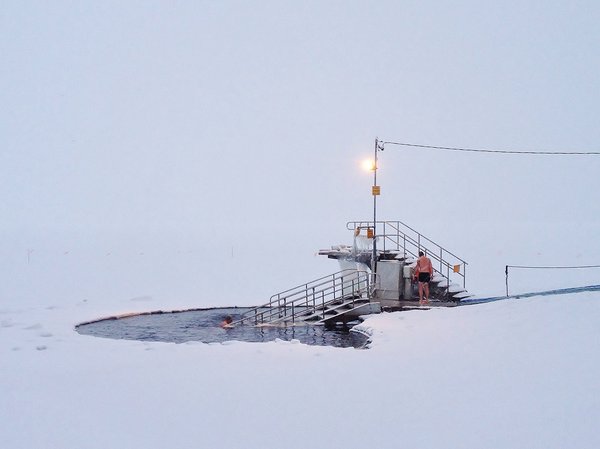Living in Tampere
20.5.2016Nine months ago I moved to a city called Tampere in Finland to live with my partner and study the Master's Degree Programme in Global and Transnational Studies at the University of Tampere (UTA). When I arrived in Tampere in August I settled in well and it didn’t take me long to find my way around the city.
I live west of the city centre and the university is in the east, which takes twenty minutes to cycle each way. It is very convenient because there are lots of bike lanes and places to park my bike at the university, therefore many people seem to cycle. For the first week I took a different route each day so I could get to know the city, see some nice landmarks, and decide on the best route. Näsinneula tower, which is the tallest observation tower in the Nordic countries, is nearby to our flat and can be seen clearly from our window. We can also see the lake from the window and it only takes five minutes to cycle to the Näsijärvi lake ‘beach’. During the summer we went swimming in the lake which was really nice because the water is so clean and clear, although there were quite a few fish!
People seem to be a lot more interested in sport here than in the UK, perhaps because it is cheap or even free. I also joined the gym at the university because it was very cheap for one year’s membership and I can go before, in-between or after lectures. It is also easy to eat healthily here. Unhealthy food is more heavily taxed than in the UK so healthy food is much cheaper. The student cafeteria often offers healthy foods. As a student it only costs €2.60 for some bread, a main meal, a side salad and two drinks, which I think is very reasonable. The health services also seem to be better quality here, including those exclusively for students. In Finland you pay for your dental treatment per hour regardless of the type of treatment. The first time at the dentist is free for students.
During the winter we were able to walk on the frozen lake to a lighthouse in the middle of the lake. There was a route on the lake where people are able to ski or ice skate. Some people even drive over the lake. It was a very interesting experience although I was nervous at first! Some foreigners can feel worried about its safety, but it is fine because they measure the thickness of the ice.
Another winter activity is winter swimming, which I did in February. Winter swimming is when a hole is cut into the ice on top of the lake to make a pool so it is possible to go swimming. They have to keep some kind of flow of water going through the pool though otherwise it freezes again. It was quite cold but it is a normal part of Finnish culture, and some people go there every week. There are many public saunas next to the lake which are used during the summer and winter. I prefer the sauna in the winter because it is a nice way to recover from the cold. Saunas were invented here and there is one in almost every house! Apparently there are more saunas than cars in Finland. Now the lake is fluid again, which is a shame because we can no longer walk on it or go ice swimming, but I am looking forward to the summer when we can swim in it again.
It is very interesting to have classes with so many different nationalities, particularly in the Finnish as a foreign language courses. When I first arrived here I was surprised at the internationality evident at UTA, and the support and facilities provided for international students. I think studying here is a fantastic opportunity because I am meeting people of nationalities that I have never encountered before and learning about their countries and cultures. It is interesting to listen to lectures by Finns or foreigners from so many different places. It is quite a new experience for me because I haven’t been in many lectures by non-native English speakers in the UK.
Here it is also possible to take online courses, which I have never come across before. For one course I took there were no physical lectures, therefore it comprised online lectures and readings, and some essays. The course selection system is very flexible, so I can broaden my knowledge by taking courses from other programmes. Furthermore, whilst studying in the UK can be very expensive, my Master’s degree here is completely free of tuition fees. The relationship between lecturers and students is also much less hierarchical. I was surprised that some lecturers seemed to look forward to learning from us, as well as us learning from them.
I have always thought that Finland seems very aware about environmental and sustainability issues. The university offers many courses in sustainability and international development. It also has a sustainability coordinator who organised a campus tour of the sustainable facilities and a recycling room where you can bring and take unwanted clothes, shoes and items. There are also various bookshelves around campus which serve the same purpose with books and stationery.
Overall I feel that Finland is welcoming to foreigners, which I believe promotes the international image of Finland and even has some long-term economic benefits. Foreigners are spending money and having people visit them here, which boosts the economy and increases tourism. I am disappointed with the Finnish government's introduction of tuition fees for non-EU students as of next year because I think this will impact the internationalisation of Finland and its subsequent benefits.
As English is considered a lingua franca and it is my native language, I am lucky enough to be able to use my native language whilst travelling to many other countries. Whilst it is useful, I think that the widespread use of English or other languages such as Mandarin and Spanish discourage their native or fluent speakers from learning other languages. Therefore I want to make the most of the opportunity I have to learn Finnish whilst I am here. For those who are surely only staying in Finland temporarily, perhaps it can be difficult to see the benefits of learning Finnish. However, I think many long-term benefits exist, such as something to add to your CV to show that you’re engaged, enthusiastic, motivated, and perseverant. In my opinion, I would like to take the opportunity to learn as many languages as possible, regardless of how widely used they are.
Although the cost of living, particularly food, is fairly expensive, I don’t actually think Finland is as expensive as many people think. Whilst I don’t live in a student residence, which are especially cheap, I still think rent prices are fair. If you book far enough in advance, long distance trains and buses can also be cheap. For local buses I have a student bus pass, so each journey costs €1.30. Each trip lasts for one hour so that it is possible to changes buses without paying again. It is also possible to get an unlimited monthly pass, which costs €34 for a young person or student. Then each trip is even cheaper, which is particularly useful during the cold and snowy winter.
It can be difficult to find a job because even jobs such as cleaning require fluent Finnish. However, if you are perseverant and innovative I believe it is possible to find something, or even establish your own business. In January I had an interview for a restaurant that opened in February and I got the job! I had to take an exam about food hygiene to get a ‘hygiene passport’, which everyone must have no later than within three months of starting a food-related job. Although the job advertisement said that no Finnish language skills are required and the restaurant has employed some foreigners, I try to put my Finnish into practice whilst taking orders, even though it sometimes leads to miscommunication and confusion. At first my progress at work was quite slow and I felt nervous about speaking Finnish to the customers, but now I have got into the routine and enjoy my work because the atmosphere is usually fun and relaxed. It keeps me pretty busy but it is manageable.
I have also been trying to get involved in some other activities inside and outside university. As I am receiving an education without tuition fees I want to give back to UTA, Tampere and Finland itself in various ways, such as through volunteering initiatives. In addition to joining the Tampere – All Bright! Ambassador network, I was chosen as a UTA Student Ambassador. In a similar way to the Tampere – All Bright! Ambassador network’s international promotion of Tampere, being a UTA Student Ambassador involves representing UTA to prospective students and marketing the University of Tampere in my own social media channels. It also gives me the opportunity to answer applicants' questions in various media and provide an authentic student perspective through sharing my experiences as an international student. A few months ago some friends and I were interviewed about being UTA Student Ambassadors for an article in a local newspaper. I also had an article published the UTA’s science and culture magazine called ‘Aikalainen’. Recently I had a photo selected for an exhibition called ‘Finland through international photographers’ lens’.
I am also part of the Erasmus in Schools project, through which I visit Finnish schools to talk to students about English language and culture and answer their questions in order to learn more about the Finnish culture and schooling system. This year I have joined the UTA Student Union (Tamy) Committee for International Affairs, which develops the involvement of international students in student life. I have also been accepted as an international tutor, a role in which I will help new international students arriving in autumn, spring and possibly also the summer to get accustomed to student life at the university.
----------------------

